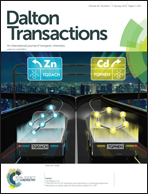Evidence for a SN2-type pathway in the exchange of phosphines at a [PhSe]+ centre†
Abstract
A range of thio- and seleno-phosphonium cationic complexes [RE(PR′3)]+[X]− (R = Me, Ph; E = S, Se; X = GaCl4, SbF6) have been synthesised and structurally characterised. Reaction of [PhSPPh3][GaCl4] and [PhSePPh3][GaCl4] with PtBu3 results in the ready transfer of the “RS+” and “RSe+” fragments from PPh3 to the stronger electron donor PtBu3. NMR experiments combined with an Eyring analysis on the corresponding degenerate phosphine exchange reaction allowed the thermodynamic values for the phosphine exchange reaction of the sulfur cation (ΔH‡ 18.7 ± 12.0 kJ mol−1; ΔS‡ −99.3 ± 36.3 J mol−1 K−1) to be compared with the corresponding values (ΔH‡ 2.4 ± 1.1 kJ mol−1 and ΔS‡ −58.1 ± 5.0 J mol−1 K−1) for the [PhSePPh3]+ system. Importantly, the large negative entropy of activation and linear dependence on the rate of exchange are compatible with an SN2-type exchange process. This conclusion is supported by DFT calculations which confirm that the phosphine exchange process occurs via an associative mechanism. The rate of exchange was found to increase from sulfur to selenium and those with aryl substituents underwent exchange faster than those with alkyl substituents.
![Graphical abstract: Evidence for a SN2-type pathway in the exchange of phosphines at a [PhSe]+ centre](/en/Image/Get?imageInfo.ImageType=GA&imageInfo.ImageIdentifier.ManuscriptID=C4DT02253J&imageInfo.ImageIdentifier.Year=2015)
- This article is part of the themed collection: In memory of Professor Kenneth Wade

 Please wait while we load your content...
Please wait while we load your content...